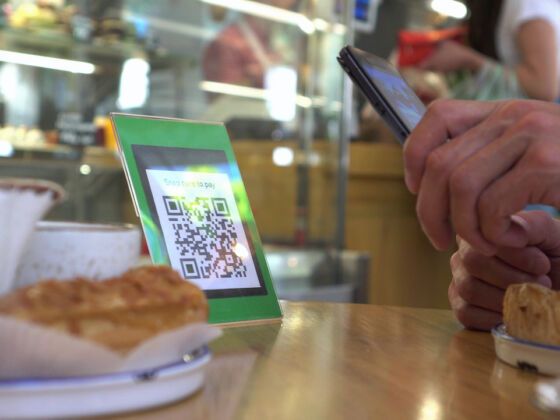The smartphone tractor beam may well be the downfall of society. Somehow it turns an otherwise normal, productive person into a dumbfounded captive of a five-inch screen, stroking its glass surface until their fingers get sore. And it’s not like we’re learning Cantonese or the dark ancient secrets of the Incas on there. We’re probably just looking at pictures of lasagna.

QR Codes Ruin the Magic of Restaurants. They Should Be the First to Go Post-Pandemic.
The tractor beam not only makes us drooling zombies, it also wrecks havoc on social occasions. It’s not exactly new. If you took a look around an office happy hour or bar mitzvah (back when those were common things people did), you’d see anyone not actively engaged in conversation or bad dancing staring head-on into their phones.
Restaurants, however, were often a safe haven from the tractor beam, forcing us all to interact lest we look like we’re on a bad date. That is, until the pandemic hit, and restaurants replaced their handheld menus with scannable QR codes.
Being on your phone at a meal was once bad form unless you felt the burning need to chronicle your beet salad. Now, busting it out is literally the first thing you do after telling the waiter, “No, tap water is fine.” Reading the menu — which was once the grand announcement that you’d arrived at a restaurant that doesn’t offer souvenir action figures — is just another excuse to scroll.
Scroll down for cocktails. Scroll up for appetizers. Swipe right to see our catch of the day. It’s Tinder for entrees, beginning your meal in the last place it should: with your face buried in your phone.
Are we free to put our phones away once we’ve ordered? Sure. Will we? Probably not, because while we were deciding between the black bean soup and the lobster bisque, a notification came in that someone had posted a picture of lasagna. And after that, a text message from someone who you half wanted to talk to. And after that an email. And before you know it, you’re eating dinner in the tractor beam.
As if forcing us out of the real world and back into our phones wasn’t bad enough, QR codes also make looking at menus vastly more complicated. A hand-held menu was like a tableau of culinary wonder, where I could visually compile a meal by darting my eyes between appetizers, entrees, and rum-based cocktails. Maybe at the Cheesecake Factory I’d need to turn some pages, but it was a pretty simple process.
Now, if I want to look at drinks and entrees I’m toggling windows like an addictive sports bettor. Or having to scroll all the way to the top of a menu to remember if I wanted any of the appetizers I’d read about seemingly three hours ago.
QR codes also make a very bold assumption that everyone walking to a restaurant owns a smartphone with unlimited internet access (or at least enough data that scrolling through a bunch of pages and PDFs won’t ruin their monthly data allotment). Sure, unless you’re a toddler or a time traveler from 1860, you probably have one. But someone, at some point, has walked into a restaurant who didn’t. Or, more commonly, spent the whole day scrolling and now has to stay on airplane mode to make sure they have enough juice to call an Uber home.
Do these people not deserve menus? Are they second-class guests who must ask for something that used to be as automatic as a fork? Forcing the poor hostess to scramble around her stand to find one or, worse, call a manager? It’s an unnecessary extra step that can be solved by ditching QR codes forever, and makes restaurants more appealing to those who don’t want their phones at dinner.
Restaurants, which had an extremely tough 2020, would be justified to say using QR codes saves them money on menu printing. And, if the world is going to insist on disposable menus for the foreseeable future, QR codes might also save some trees. But an industry that’s increasingly obsessed with serving its food in single-use containers crossed the excessive-waste bridge a long time ago. And of all the expenses restaurants face, photocopies of menus are down there with ice.
Some might say QR codes are more sanitary than handheld menus, since nobody else has been touching your phone. Except you. Probably while you’re in the bathroom, which is part of the reason why your phone is one of the dirtiest, most germ-filled things you touch all day. And if you look at a menu as something — like your table and silverware — which has been touched by strangers but is easily cleaned, there’s no reason not to use them.
Some people love QR code menus, and for them I suppose they’re a nice option to have. But the restaurant experience is about being anywhere but on your phone, and QR code menus force us onto them immediately. Once the pandemic is over, or at least as over as it’s going to get, QR menus need to go the way of partially-hydrogenated oil and smoking sections, and get out of restaurants forever. Dinner doesn’t need to be another trip into the tractor beam, and menus that don’t involve death scrolls will be a welcomed return to normalcy.
Editor’s note: This is an Op-Ed article. The opinions expressed in this article are the author’s own.